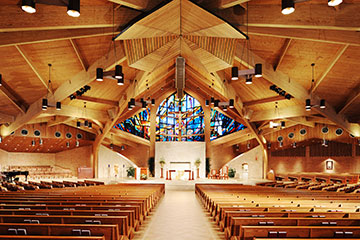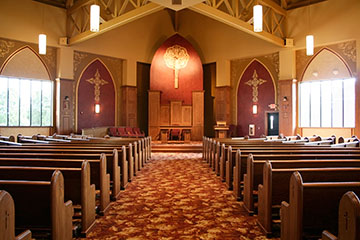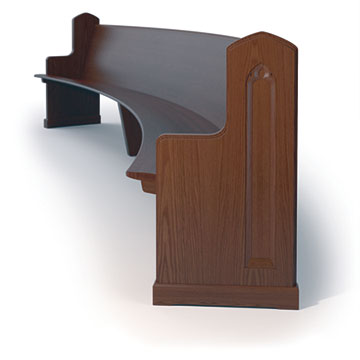
By John Chastain
Ask the right questions to make an informed decision.
 Whether your church is renovating an existing space or building a new one, worship seating represents a major investment for your congregation. A myriad of choices is available — type, style and options. So, asking the right questions of a potential seating supplier can eliminate confusion, help to narrow your search, and save time.
Whether your church is renovating an existing space or building a new one, worship seating represents a major investment for your congregation. A myriad of choices is available — type, style and options. So, asking the right questions of a potential seating supplier can eliminate confusion, help to narrow your search, and save time.
The following guidelines for two of the most popular types of congregational seating — pews and auditorium seating — will help you gather the appropriate knowledge to make an informed decision about one of the largest expenditures in your church’s building or remodeling project.
10 questions to ask about pews
While worship seating options have greatly increased in recent years, pews continue to be a popular choice for churches of every denomination. But, it can be challenging to determine the difference between a poor- and good-quality supplier and product.
To that end, there are 10 questions to ask before a final decision is made. This way, your church can be confident it’s practicing good stewardship.
1) How stable is the company? What information can the company provide to your church in regard to its corporate health? A Dun and Bradstreet financial rating is a good place to start. Stable companies have been in continuous operation, in the same location, under the same ownership, for a period longer than their warranty.
Further, ask an architect with significant church project experience which pew companies he trusts.
2) How is the project handled, from pre-order to post-installation? Insist on:
• A local representative who will answer many of these 10 questions, as well as provide product samples and timely on-site service (including as-built field measurements).
• A dedicated factory project coordinator to shepherd the order through production and delivery.
• A CAD operator responsible for the scale seating plan drawing, based on field measurements.
• On-time installation. Check with architects and church references regarding which companies have consistent lead times and install as promised.
• Terms; a deposit will be required, but the balance shouldn’t be due until after the pews are installed.
3) Can several project references — within reasonable driving distance — be provided? Visiting actual installations that aren’t brand-new is a proven way to evaluate how well products perform over time.
4) Is a wide variety of worship products and options available? If your straight or radius pews, choir chairs, pulpit and custom furniture can be provided by the same source, your church will save time and limit risks.
5) What types of assurances of material quality can be provided?
What wood will be used? An on-site factory pre-dryer and kiln-dryer ensures that the wood will be milled at the optimum moisture level. Note that “solid wood” alone doesn’t guarantee quality. Answers to Question No. 8, below, are more reliable indicators.
What type of fabric will be used? Fabrics should be independently rated as heavy duty and include stain resistance. COMs (customer’s own material) should be an option, but only if the pew company pre-tests the fabric.
What will the finishing process entail? A combination of hand and mechanical application works well. Additionally, a topcoat of catalyzed varnish is more resilient than a lacquer finish.
 6) Are several choices of wood species and fabric patterns available? Quality companies offer several species of wood and more than one type of cut. In terms of fabric selection, the choice is easier when a wide variety of pattern choices — not just a few — are available.
6) Are several choices of wood species and fabric patterns available? Quality companies offer several species of wood and more than one type of cut. In terms of fabric selection, the choice is easier when a wide variety of pattern choices — not just a few — are available.
7) Are several seat and back choices available to suit your unique needs? An ergonomically contoured seat base under the seat cushion is more comfortable than a flat seat base. Seat options should include high-density (HD) or high-resiliency (HR) seat foam, spring seats, divided seats and wood seat options. Too much foam (4 inches or more) on a flat seat can trap heat, and it tends to cause the fabric to stretch more than it should, which can lead to wrinkling. Multiple seat back options for lumbar support should be available. For kneelers, cold-molded foam that wraps over the edges of the substrate provides better comfort and holds its shape well.
8) How are issues such as design, joinery and attachments used to enhance durability? Ends may be routed to receive seats and backs. A back attachment may be fastened to the seat with screws, not nails; screws should be driven into solid wood. Cap rails should offer tongue-and-groove construction for attachment to the back, preventing loosening. Contoured seat bases can use the engineering principle of the arch to provide superior strength, and to prevent sagging without adding the bulkiness of additional boards. Fasteners should never be exposed. Finally, when longer lengths are spliced, a support should be located directly under the splice, and concealed turnbuckles should be used to tighten sections together.
9) How are the pews installed? And, what does the warranty include? Installation should be based on an approved CAD drawing. Pews should be assembled and anchored by experienced pew installers. Supports should be scribed to their specific position before anchoring to ensure a permanent, tight fit. Warranties should cover 25 years for wood and 15 years for upholstery foam/fabric. Non-prorated coverage is best.
10) What’s the initial price and long-term cost of ownership? Many church leaders admit that they used price to qualify potential suppliers before asking any of the first nine questions above, only to regret it later. Higher-quality pews will be more expensive, but they’ll also be more comfortable, look better and last longer. Here’s a basic cost comparison:
- Lower-quality pews: $50,000 / 25 years = $2,000 / year = $167 / month, plus maintenance costs
- Better-quality pews: $60,000 / 25 years = $2,400 / year = $200 / month with no maintenance costs
10 questions to ask about auditorium seating
Although potentially higher in cost than pews or chairs, auditorium- or theater-style seating for worship areas has enjoyed a surge in popularity in recent years. With so many choices available, there are some important questions for every church committee to ask before making a decision.
1) How much experience does the manufacturer have with religious institutions? Most auditorium seating was originally designed for theaters and stadiums. Churches have unique needs that aren’t always understood by firms with little worship seating experience. There are distinct advantages to working with a company that has a reputation for professional church project management.
2) Is the product produced in the United States, or does the company rely on foreign parts and assembly? The latter might be subject to political issues or shipping delays. Look for companies that source at least 75 percent of component parts domestically and perform 100 percent of assembly domestically.
3) What materials are used in the seat and back cushions? Are they shaped to follow the body contour? Is the seat substrate also contoured? Cold-molded foam designed specifically for the seats and backs allows ergonomic contouring and will hold its shape better over time than other foams. A contoured seat substrate will be more comfortable than a flat seat base.
 4) Does the system rely on a spring-lift mechanism, or is it designed to let gravity retract the seat? Gravity-lift systems are quiet and will stay quiet, while mechanical methods tend to be noisier — especially after years of use.
4) Does the system rely on a spring-lift mechanism, or is it designed to let gravity retract the seat? Gravity-lift systems are quiet and will stay quiet, while mechanical methods tend to be noisier — especially after years of use.
5) Are the cushions designed for easy removal? And, is there provision for replacing the seat and back covers without the cost of a professional upholsterer? Can the various seating component parts be easily replaced if needed? The cost of ownership is much less if the answer to these questions is “yes.”
6) Can the seating be aligned with aisles without the use of several different seat sizes, which affects overall appearance? Are wider seats available for specified areas if you want to provide for larger people? Are removable units offered? Can arms, drink holders or other accessories be added later if needed? Many churches see their needs change over time and need seating that can grow with them.
7) When seats are in the up position, is the profile 19 inches deep or less? A slim profile provides for more standing and walking space. And, comfort doesn’t have to be sacrificed if the seats and backs are contoured with high-quality foam.
8) How much maintenance will be needed or required? For seating systems with springs, some manufacturers require regular lubrication to maintain the warranty. This can be time-consuming if the mechanism isn’t easy to reach, adding cost to ownership.
9) Does the company have a reputation for timely performance, or have there been issues from time to time? Ask an architect who works on church projects in your area for input. Insist on reference installation locations.
10) Is the company willing to send a professional representative with product samples, or will it simply ship them to you for inspection? Most churches have little or no experience with this type of seating, making it difficult to understand what they’re seeing — and the samples can’t speak! Take the time to schedule a meeting with an experienced professional who can provide the information you need, and to answer questions that inevitably arise.
Decision time!
Often, the individuals involved in the purchasing decision of worship seating — pastors and building committee volunteers, typically — will only make this type of purchase once in a lifetime. As such, choosing a supplier that’s willing and able to provide the knowledge, support and education needed to make an informed decision is critical.
The guidelines above will help decision-makers feel confident in their choice of a seating supplier and help alleviate the pressure of choosing seating products for the church.
John Chastain of Chastain Associates in Maineville, OH, is the territory sales representative for Sauder® Worship Seating.
RadianceTM Curved Pews
 Radiance is Sauder® Worship Seating’s debut into the curved pew market, and the direct result of extensive research and design based on architect, designer and customer influences.
Radiance is Sauder® Worship Seating’s debut into the curved pew market, and the direct result of extensive research and design based on architect, designer and customer influences.
Radiance curved pews are manufactured to exact location specifications; the curve of each pew is calculated and engineered to the precise concentric radius required for the worship space for a truly customized seating layout. Seats feature the company’s unique ergonomic contour and are constructed of solid hardwood staves for enduring support and natural aesthetics.
Radiance curved pews are covered by the same 25-year warranty as Sauder’s straight pews. The new product line coordinates with a full line of accessories and is available in eight standard wood species and 11 finish colors.
Sauder Worship Seating is internationally recognized as one of the United States’ oldest and foremost design-manufacturing firms for worship furniture and is considered a premier resource for innovative seating products. Sauder provides CAD-driven space planning and layouts, seating consultation and complete project management, from planning through installation.
sauderworship.com
(800) 537-1530


